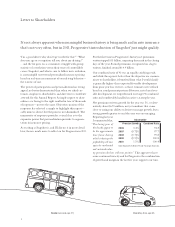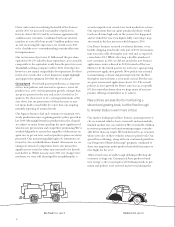Progressive 2011 Annual Report Download - page 20
Download and view the complete annual report
Please find page 20 of the 2011 Progressive annual report below. You can navigate through the pages in the report by either clicking on the pages listed below, or by using the keyword search tool below to find specific information within the annual report.
21
OPERATIONS SUMMARY
Personal Lines Our focus on growing our policyholder
base is now consistently resulting in more customers and
more revenues. In 2011, Personal Lines added more than
580,000 policies (5%) and achieved $13.6 billion of net pre-
miums written, a 5% increase from the previous year. After
several years of erosion in written premium per policy for
our auto programs, we are seeing some encouraging signs,
especially in new auto business where premium per policy
was up about 3% for the fourth quarter.
Industry loss costs have been rising as have industry loss ratios.
That said, the personal lines insurance marketplace remains
very competitive with major players increasing marketing
efforts and another tier of players working hard to break in
to consumers’ consideration set. Agents con tinue to have an
abundance of carriers eager to serve them in most markets.
The new business climate was tougher in 2011 than 2010,
when we had more shoppers than ever before. New appli-
cations declined 1% for the year. Conversion of shoppers
was up slightly from 2010 and the fourth quarter was more
positive than the rest of the year in terms of year-over-year
shopping trends and new business applications.
Profitability was better than our targets, driven in part by
favorable loss development, which assisted our 93.2 calendar-
year results by approximately 1.3 points. Our profitability was
fairly consistent across products, geography, and distri bu tion
channels and we are now eager to grow in virtually all areas.
This is a great statement about our field product managers,
who fully own profit and growth locally and take swift action
when either of those parameters is not meeting our expecta-
tions. Progress in Florida and New York, where personal injury
protection is a significant exposure, has been encouraging
with both states improving profitability and growing while
doing so. That said, these are highly dynamic environments
so we remain vigilant in both states. Also encouraging was
the fact that our calendar results for Massachusetts showed
us close to operating profitability and structurally in a place
from which to grow.
Our cost structure continues to be very competitive and we
lowered what we refer to as our non-acquisition expense
ratio. We think of costs other than commission and advertising
as structural and reducing these will facilitate more competi-
tive pricing and more growth going forward.
Policyholder retention results, as measured by policy life ex-
pectancy, for the year were mixed. In our Agency auto business,
policyholder retention was up over 6% driven by competitive
rates and product enhancements. In our Direct auto programs,
retention eroded approxi mately 3% driven by actions we
took in some key states to address profitability and some un-
intended consequences of “on-boarding” changes we made.
We believe we have actions underway that have, or will soon
have, addressed both of these opportunities in our Direct
auto business. etention for our special lines customers was
down about 1%.
We have the luxury of distributing our products direct to
consumers and through over 35,000 agents and brokers. The
competition in mass-marketing personal lines insurance con-
tinues to escalate with advertising spend in our category now
likely 5 times what is was 10 years ago. We continue to grow
our own advertising expenditure and do so with prudence
around achieving an appropriate yield. The media consumption
of households continues to shift to digital and increasingly
mobile, and our media placements reflect those trends.
There are two key trends within our agency force that are
important to our growth
—
one ongoing and one reasonably
new for us. The ongoing trend is the shift to the use of com-
parative rating systems whereby agents can easily see the most
competitive price amongst carriers for specific customers.
This auction environment favors companies with competitive
cost structures and highly accurate segmentation systems
—
both of which we enjoy. The other trend for us is reasonably
new and very positive
—
agents more consistently consid-
ering Progressive for their preferred business. This is very
encouraging as this class of business is by far the largest avail-
able to us via our current distribution methods. Our share
in this segment is low and naturally the opportunity for
growth is significant.
We always remain diligent around rating segmentation and
2011 was no exception. Within our auto products, we added
rating on occupation in 12 states, improved rating on house-
hold structure, further refined segmentation of non-indemnity
costs, and began to get more facile in up-front underwriting.
Our normal course and aspiration is to accept and price
all
risks. We’ve become more cognizant of applicants whose
intent is not to insure but to defraud and we are taking a
proactive approach to identifying the distinction. We think
this focus allows for substantially more competitive pricing,
especially in urban environments. In our special lines pro-
grams, we continued the roll out of rating based on operator
experience and length of ownership, and we introduced
optional declining deductibles in motorcycle.
Van Gogh Van (Jason, age 38)Vrooom (Milan, age 21)
























